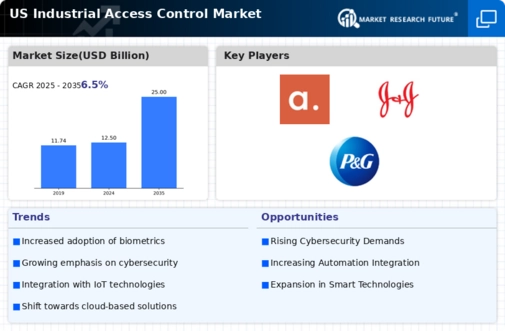Rising Security Concerns
The industrial access-control market is experiencing growth driven by escalating security concerns across various sectors. Organizations are increasingly prioritizing the protection of sensitive information and assets, leading to a heightened demand for advanced access-control solutions. In 2025, the market is projected to reach approximately $5 billion., reflecting a compound annual growth rate (CAGR) of around 10%. This trend indicates that businesses are investing significantly in technologies that enhance security measures, such as biometric systems and smart locks. As threats evolve, the industrial access-control market is likely to adapt, offering innovative solutions that address these challenges. The focus on safeguarding physical and digital assets is expected to remain a key driver, influencing purchasing decisions and shaping the future landscape of security solutions.
Technological Advancements
Technological advancements play a pivotal role in shaping the industrial access-control market. Innovations such as artificial intelligence (AI), machine learning, and the Internet of Things (IoT) are transforming traditional access-control systems into more sophisticated solutions. These technologies enable real-time monitoring, data analytics, and enhanced user experiences. In 2025, the integration of AI in access-control systems is anticipated to increase by 15%, indicating a shift towards smarter security solutions. As organizations seek to streamline operations and improve security protocols, the demand for technologically advanced access-control systems is likely to surge. This trend not only enhances security but also improves operational efficiency, making it a crucial driver in the industrial access-control market.
Regulatory Compliance Requirements
Regulatory compliance requirements are increasingly influencing the industrial access-control market. Organizations are mandated to adhere to various regulations concerning data protection and security, such as the Health Insurance Portability and Accountability Act (HIPAA) and the Sarbanes-Oxley Act. These regulations necessitate the implementation of robust access-control measures to safeguard sensitive information. As compliance becomes more stringent, businesses are compelled to invest in advanced access-control solutions to avoid potential penalties and reputational damage. In 2025, it is estimated that compliance-related investments in access-control systems will account for approximately 20% of the market. This trend underscores the importance of regulatory frameworks in driving demand for effective security solutions within the industrial access-control market.
Increased Investment in Infrastructure
Increased investment in infrastructure is a significant driver of the industrial access-control market. As industries expand and modernize their facilities, there is a growing need for enhanced security measures to protect new assets and technologies. The U.S. government has allocated substantial funding for infrastructure projects, which is expected to boost the demand for access-control systems. In 2025, the market is projected to benefit from an influx of investments, with an estimated growth rate of 12% attributed to infrastructure development. This trend highlights the correlation between infrastructure investment and the need for advanced security solutions, positioning the industrial access-control market as a critical component in safeguarding new developments.
Growing Demand for Remote Access Solutions
The growing demand for remote access solutions is reshaping the industrial access-control market. With the rise of remote work and the need for flexible access to facilities, organizations are increasingly seeking solutions that allow secure remote entry. This trend is particularly relevant in sectors such as manufacturing and logistics, where employees may require access to facilities from various locations. In 2025, the market for remote access solutions is expected to grow by approximately 18%, driven by the need for secure and efficient access management. This shift towards remote capabilities indicates a broader transformation in how organizations approach security, making it a vital driver in the industrial access-control market.













Leave a Comment